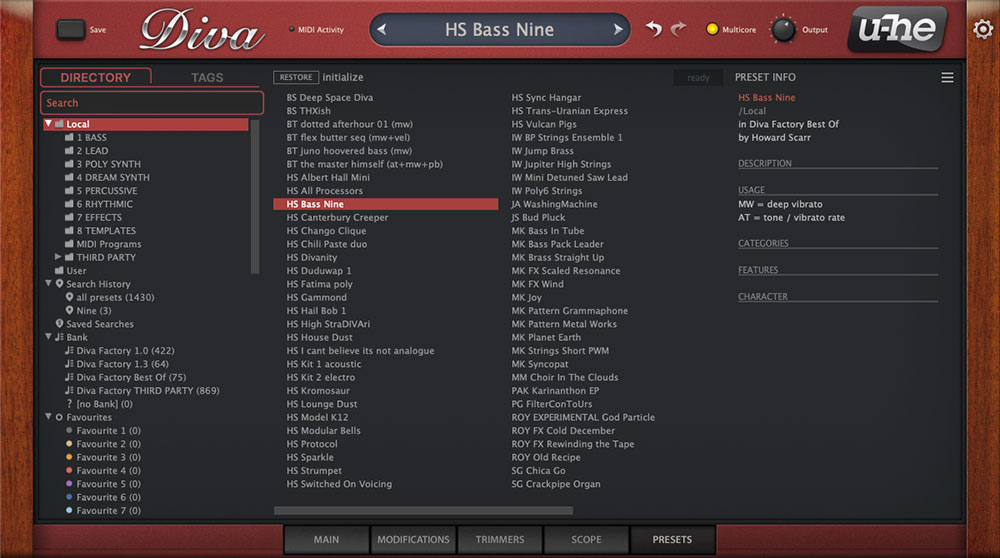
The last item I'd like to draw your attention to is the Mixer's feedback. Next, and returning to the unexpected, the Triple VCO sports an FM control, with VCO1 acting as modulation source.

Two oscillators, when mixed, create a rich and swirly lushness - very like a real Mini. For example, I was impressed that the Detune control prevented the oscillators from perfectly soft-sync'ing together. However, it's important to understand that this is not a 1:1 Minimoog emulation, even though some aspects are delightfully close. Nor can the Triple VCO achieve the other Minimoog trick of modulating by noise, because the two LFOs don't have it. There are two generic LFOs available regardless of the oscillators selected, so you never need to draft in VCO3 as a modulation source. Modulating the shape between square and narrow pulse produces a most un-Mini-like (and slightly pitch-wavering) PWM. The waveform selector offers a continuous blend between available waveforms, unlike that of the Model D Minimoog, and this blend may be modulated, its default source being LFO2. Extras include synchronisation of VCO2 and 3 and a series of switches enabling pitch and shape modulation, one switch for each oscillator. It's also the Diva component that occupies the most screen space, its Mixer extending over the area otherwise available to the high-pass filter. Essentially, it's a Minimoog oscillator bank with extras. The most complex of the oscillators is the Triple VCO. OscillatorsĬheck out the Trimmers section, with its subtle individual voice detuning warming up this Jupiter 6-based patch. The lower section features five buttons that reformat the panel immediately above to juggle features less related to hands-on tweaking. A double-click sets any control to its default value and, for the mouse‑shy amongst us, a basic MIDI learn system enables assignment of external controllers, adding tactility to the Diva experience. The mouse has to move an unexpectedly large distance before an oscillator switches octaves, but other than that, there was nothing to slow me down and I was soon whizzing about. The interface is set in a tasteful maroon panel with wooden end-cheeks and in resolutions to suit any monitor. Although the elements can be swapped freely, Diva's purpose is not to impersonate any one synth specifically. These fine instruments form the basis of Diva's oscillators, filters and envelopes, with a few judicious tweaks here and there.

In no particular order, they are: Moog's Minimoog, Roland's Jupiter 6, Jupiter 8, Alpha Juno and Juno 60, and Korg's MS20.

#U HE DIVA MULTI CORE MANUAL#
With one exception I've owned them all at some time or other, making this one of the briefest sessions of 'getting to know you' ever.īut what are these classic analogues from which Diva's inspiration is drawn? The manual doesn't say explicitly, but the hints are easy to follow, and if you need more clues, Diva's panel graphics and 'Init' patches should sort it. It's rare that a new plug-in feels instantly familiar, but Diva achieves this by sneakily borrowing important bits from a number of well-known synths. My appetite whetted, I installed version 1.1 on my Mac, keen to test the promised 40 percent CPU saving over version 1.0. But such realism has a cost, and in its highest resolution mode ('Divine'), Diva needs a pretty powerful computer to hit the 16-voice maximum that it can deliver. Its main components resemble those of half a dozen classic instruments and it boasts enigmatic 'zero-delay-feedback' filters. Uhe's Diva is proudly advertised as a 'game-changer': a software synth sounding so analogue you'll need to replace its capacitors in 30 years or so. For many, the convenience, affordability and flexibility of modelled reality already trumps those final few percentage points of difference. In the cinema and in the studio, the gap between real and digitally created experience narrows each year. Not quite an MS20 - its envelopes weren't the best ever, so here are a couple of alternative choices and let's bung in a Juno high-pass filter too. Uhe's painstakingly authentic analogue emulation is pretty demanding.


 0 kommentar(er)
0 kommentar(er)
